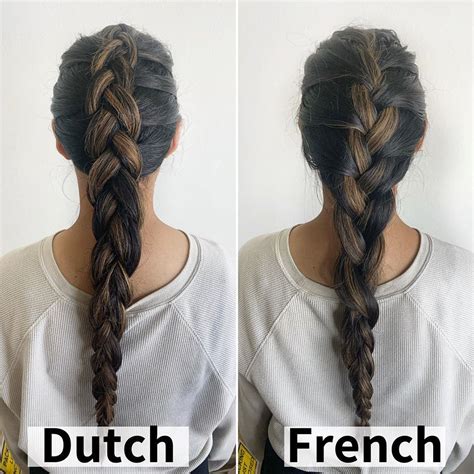When it comes to braiding, there are two main contenders: Dutch and French braids. Both of these techniques can create beautiful and intricate hairstyles, but they have some key differences that set them apart.

Construction
- Dutch braid: The Dutch braid is created by starting with three strands of hair and crossing the left strand over the middle strand, then crossing the right strand over the new middle strand. This process is repeated, always crossing the strands under the middle strand.
- French braid: The French braid is created by starting with three strands of hair and crossing the left strand over the middle strand, then crossing the right strand over the left strand. This process is repeated, always crossing the strands over the middle strand.
Appearance
- Dutch braid: The Dutch braid has a raised, textured appearance, with the strands crossing over each other in a tight, intricate pattern.
- French braid: The French braid has a flatter, smoother appearance, with the strands crossing over each other in a more subtle way.
Tightness
- Dutch braid: The Dutch braid is typically tighter than the French braid, as the strands are crossed under the middle strand, which creates a more secure hold.
- French braid: The French braid is typically looser than the Dutch braid, as the strands are crossed over the middle strand, which creates a more relaxed hold.
Complexity
- Dutch braid: The Dutch braid is slightly more complex to create than the French braid, as it requires crossing the strands under the middle strand.
- French braid: The French braid is relatively easy to create, as it only requires crossing the strands over the middle strand.
Popularity
- Dutch braid: The Dutch braid is a popular choice for athletes and people with thick, coarse hair, as it creates a secure hold that will stay in place all day.
- French braid: The French braid is a popular choice for people with fine, thin hair, as it creates a more subtle, relaxed look.
Deciding whether to choose a Dutch or French braid depends on your personal preferences and hair type. If you want a secure, tight braid that will stay in place all day, the Dutch braid is a great choice. If you want a more relaxed, subtle braid, the French braid is a better option.
Dutch Braid
- Start with three strands of hair and cross the left strand over the middle strand.
- Cross the right strand over the new middle strand.
- Take a small section of hair from the left side and add it to the left strand.
- Cross the left strand (with the added hair) over the middle strand.
- Cross the right strand over the new middle strand.
- Repeat steps 3-5 until you reach the end of your hair.
- Secure the braid with a hair tie.
French Braid
- Start with three strands of hair and cross the left strand over the middle strand.
- Cross the right strand over the left strand.
- Take a small section of hair from the left side and add it to the left strand.
- Cross the left strand (with the added hair) over the middle strand.
- Cross the right strand over the new middle strand.
- Repeat steps 3-5 until you reach the end of your hair.
- Secure the braid with a hair tie.
- Not starting with damp hair: Damp hair is more pliable and easier to braid.
- Using too much product: Too much product can make your hair greasy and difficult to braid.
- Braiding too tightly: Braiding too tightly can cause pain and damage your hair.
- Not securing the braid with a hair tie: A hair tie will help to keep your braid in place.
Dutch and French braids can be used to create a variety of different hairstyles, including:
- Pigtails: Simply braid two Dutch or French braids and secure them with hair ties.
- Half-up hairstyles: Dutch or French braids can be used to create a variety of half-up hairstyles, such as half-up buns, half-up top knots, and half-up ponytails.
- Braided crowns: Dutch or French braids can be used to create a beautiful braided crown around your head.
- Accessorized braids: Dutch or French braids can be accessorized with ribbons, beads, or other hair accessories.
Dutch and French braids are two of the most popular braiding techniques, and they can be used to create a variety of beautiful hairstyles. By following the instructions in this article, you can master both of these braiding techniques and create beautiful braids for yourself and others.
